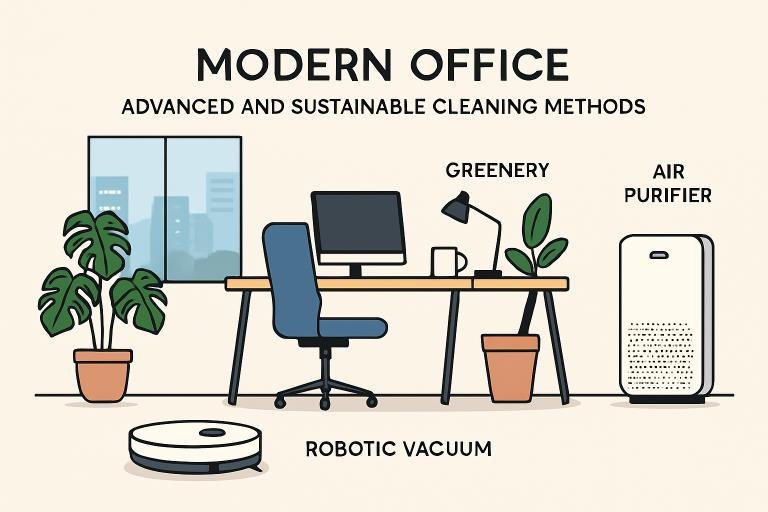Maintaining a clean and healthy workplace has become a priority for organizations that value employee well-being and productivity. Innovative cleaning approaches go beyond basic tidying, focusing instead on practices that reduce the spread of germs and improve indoor air quality. Modern strategies are reshaping how businesses think about cleanliness and safety in shared environments, from the use of eco-friendly disinfectants to the integration of smart technology.
As expectations rise, many organizations re-evaluate their cleaning routines to ensure they align with higher hygiene standards. Professional teams, such as those offering commercial cleaning services in New Castle, often incorporate advanced methods like touch-point disinfection, scheduled deep cleans, and air purification systems. These solutions highlight how thoughtful cleaning practices can contribute to healthier, more efficient workplaces for employees and visitors alike.
Embracing Smart Cleaning Technologies
The integration of smart technology is fast becoming a hallmark of innovative workplace cleaning. IoT-enabled devices continuously monitor environmental conditions and cleanliness levels, from air quality sensors to automated supply refills. Robotic cleaners, powered by artificial intelligence, can autonomously handle recurring cleaning tasks across extensive floor space—delivering consistent results with minimal human intervention. These advanced technologies provide quantifiable improvements in hygiene and free up employee time for higher-value work, propelling productivity and efficiency.
By leveraging these tools, businesses provide safer environments and cultivate a positive reputation among employees and visitors. Robotics and IoT transform cleaning from a reactive chore to a proactive, intelligent operation.
Adopting Eco-Friendly Cleaning Practices
A significant shift toward eco-friendly cleaning practices is occurring in response to increasing environmental and health awareness. Green cleaning solutions—biodegradable, non-toxic, and certified by reputable organizations—reduce exposure to hazardous chemicals. Many companies also opt for cleaning equipment with energy-saving features and water-conserving protocols, making their cleaning operations as sustainable as possible.
Switching to sustainable methods yields more than environmental benefits; employees feel safer, customers respond positively to green initiatives, and organizations can strengthen their commitment to corporate social responsibility.
Implementing Data-Driven Cleaning Strategies
Traditional fixed-schedule cleaning often results in inconsistent levels of cleanliness. Applying data analytics through sensors and monitoring tools allows dynamic, usage-based cleaning. These smart systems track foot traffic, restroom usage, and high-touch points, ensuring attention goes exactly where needed—optimizing operational costs and cleaning effectiveness.
Besides immediate resource allocation improvements, aggregated data helps facilities uncover trends and refine protocols over time. This methodical, evolving approach means workplace cleaning adapts with the organization and continuously improves. Facilities that use data-driven methods often see higher employee satisfaction and trust, especially when cleaning is more transparent and reliable.
Enhancing Indoor Air Quality
Indoor air quality often goes unnoticed but plays a significant role in workplace health. Up-to-date maintenance of HVAC systems is crucial for preventing the circulation of dust, mold, and pathogens. Employing HEPA air purifiers, regularly cleaning carpets and soft surfaces, and introducing greenery into workspaces are all proven to minimize airborne pollutants and allergens.
Fostering Employee Engagement in Cleanliness
Promoting employee participation in keeping workspaces clean fosters accountability and pride. Providing sanitization kits, clear guidelines, visual prompts, gamified challenges, and rewards sustains high standards and morale. Engaged employees report issues, creating a cycle that maintains hygiene and encourages long-term behavior change.
Leveraging Antimicrobial Coatings
High-touch surfaces like door handles and elevator buttons often transmit bacteria and viruses. Antimicrobial coatings create a continuous invisible barrier, neutralizing germs between cleanings. This reduces disease spread, especially in busy workplaces. Using these coatings with regular cleaning reassures employees and visitors, highlighting a proactive health and safety approach.
Conclusion
Innovative cleaning strategies are redefining the standards for safe and productive workplaces. Organizations achieve thorough cleanliness with measurable health benefits by integrating smart technology, green practices, real-time data, and empowering employees. Staying current with the latest trends and tools ensures the workplace remains resilient, sustainable, and attractive to existing staff and future talent. Forward-thinking businesses recognize workplace hygiene’s pivotal role in broader organizational success.



